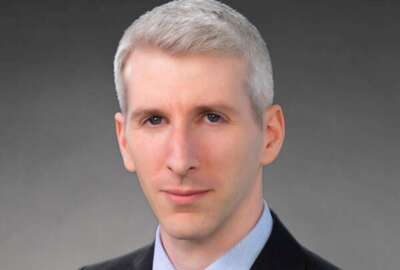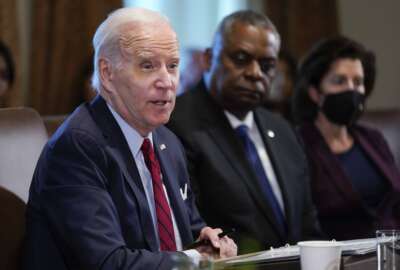What to expect at the General Services Administration under Trump Two
"Here are multiple challenges, but one that you didn't talk about is the public building service," said Larry Allen.
When it comes to the government’s procurement tab, the General Services Administration is one of the most influential agencies. It manages many of the contracts from which all agencies buy. And it one of the agencies that helps decide governmentwide procurement policy. So what should happen in the Trump administration at the GSA? The Federal Drive with Tom Temin got some ideas from long-time GSA watcher, and federal sales expert Larry Allen.
Interview transcript:
Tom Temin And interestingly, as we speak, there’s no nominee to run GSA. So we don’t really know what’s going to happen there. But what do you think should happen at GSA? What are the top challenges that maybe the Trump administration could take on?
Larry Allen Well, Tom, I think there are multiple challenges, and you referenced a couple of them in the lead, but one that you didn’t talk about is the public building service. And most people associate me with the procurement side of GSA. And trust me, that’s where I’m more comfortable. But in terms of the public building service, the incoming administration has a lot of opportunities to do some things with real estate, right sizing the federal footprint. It’s not going to be easy either. On the one hand, you’ve heard calls for federal employees to return to the office. That would suggest using more building space. On the other, we’ve heard that there may be some moves to further reduce the federal footprint, particularly in and around Washington, D.C. So it’ll be interesting to see exactly how that plays out. They’re not necessarily competing goals. You could always upgrade your office space, but it’s going to have to be something that gets a lot of attention. And traditionally, inside the General Services Administration, the public building service does usually get most of the attention.
Tom Temin Yes, that’s right. We tend to think of it as the IT procurement shop and so forth, which is the big dollar item. But really, if you talk about big dollars, federal real estate is definitely it. And they can only have so much control over what happens, because an agency that decides to keep renting its space, which is two-thirds underutilized, well, that’s not GSA’s business directly. They can only maintain the lease for that agency, but it’s up to the agency to decide how much space it needs.
Larry Allen It is. GSA can encourage tenants to move out, but they can’t require it. And so that’s going to be something that definitely limits the agency’s ability to reduce overall real estate portfolios. So again, that’s going to be something that I suspect gets a lot of attention. But let’s switch gears to the things that you and I like to talk about, which is IT procurement. And I think one of the big things that needs some attention right up front, Tom, is the FedRAMP process. This is the process that companies have to go through if they want to offer cloud based solutions to the government. And it’s really become a bottleneck for a lot of companies and not an inexpensive bottleneck. Even though GSA has tried to take some interim steps to reduce the overall cost, it can still cost the company hundreds of thousands of dollars to go through the FedRAMP accreditation process and take months, if not longer. Both of those are a problem and they need to be addressed. And one of the things that I would hope that the incoming administration would look at is whether or not there are some commercial industry standards, like a NIST standard or something that’s acceptable in the IT industry for cloud security that gets people most of the way there, if not all of the way there, so that you’re not having to go through the same ground again if you’re a cloud based provider that’s doing business commercially, or you’re reselling commercial based cloud solutions. Everything is going to the cloud. Everything. It’s foundational now. Even a lot of AI stuff is based on cloud based solutions. So we need to find a way to fix FedRAMP and remove that bottleneck. And again, I think one way to do that is to look and see what’s already out there in the marketplace that maybe can assist in that process.
Tom Temin We’re speaking with Larry Allen, president of Allen Federal Business Partners. I guess in the same vein, we hear talk of the possible expansion of the cybersecurity maturity model certification program of DoD coming over to the civilian side of government, presumably through the GSA. And in the spirit of FedRAMP, meaning what you do for one is good for what you do for the others. Maybe they could, if they decide to go the CMMC style route, GSA could keep things simple and say, Well, we’ll do it just like the way they do it. Instead of reinventing this kind of contractor certification program for the civilian side since all the work’s been done.
Larry Allen Well, I think if you’re going to expand CMMC government wide, which in some degree I think is inevitable, having a do once use many framework that you suggest is exactly the way to go. And it’s actually not a hypothetical issue. We’ve already seen the Department of Homeland Security, for example, making moves to implement its own CMMC standard, which will be first cousins to its DoD counterpart, but of course not exactly the same. You can see where other agencies would follow along and do things that were similar, but not the same based on their own needs. The result would be a tremendous expense for industry, really favoring large entrenched government contractors at the expense of innovative businesses and new market entries. So if the government is serious about wanting to do business with these types of companies, one of the things it could do would be to say, all right, cybersecurity is a perceived focus area. It’s an important good. We’re going to have this standard and it’s going to be the standard for everyone. And whether it’s GSA that runs it, and I think there is a strong case for that or somebody else, you don’t want to have each agency going off and doing their own thing.
Tom Temin And what’s your sense of what should happen, if anything, with the schedules, programing? That has been something that people have been working on forever. It’s a continuously evolving opus, you might say, the multiple awards schedule system. And with all those different schedules now, it’s effectively one big schedule, and that took a few years to kind of come into play. Are we at the end state, the continuous end state for the MAS?
Larry Allen I think one of the biggest problems with the schedules program today is that it’s spread across four different business lines in the Federal Acquisition Service. And the result is that you got not really a unified program. Each part does the schedules program its own special way. If you look at the IT acquisition space, they do things a certain way that’s similar, but not exactly like the way the professional services group does it. And then if you go look at the general services and products part, the traditional commercial item, part of the schedules, they still have other procedures and processes that they use. The schedules program did over $50 billion in business in FY24. It is past time for there to be a unified schedule program management office. I think GSA needs to look strongly at creating an assistant commissioner position to run the schedules program. When you look at smaller contracts, but very important, like Alliant 2 and OASIS, those are big programs that drive a lot of business, but not anywhere near what the schedules program does. And each of those has their own program management, centralized office structure. And if you want to schedules program to work better, get contracts done more quickly, have unified set of standards, you need to have that central management.
Tom Temin And one thing GSA has worked on over the years is the physical workspace of the federal employee. I remember during the Clinton administration, I think they did it again in more recent years, even under the Biden administration, but set up the ideal workstation work environment, and hears different models of how that might look. I remember wandering through them somewhere in a setup that they had way back during the Clinton administration when PCs were still burgeoning out and people, you can have two monitors who says you have to have just one, this kind of thing. I wonder if the telework, since this is going to be something we don’t know the extent that’s going to be curtailed by the Trump administration, but there’s going to be telework. I wonder if that’s something they could do, is just say, here’s what the ideal telework setup looks like. Maybe that would be a way to mollify the Trump people that don’t like telework.
Larry Allen I think you’re going to have to address this in some way, shape or form specifically at GSA. Ten years ago, there were four office buildings for the General Services Administration in and around Washington, D.C. Today there is one. So even if you wanted to bring all GSA employees back to work, you couldn’t because there simply isn’t enough space to put them. So you’re going to have to find a way to have flexible office space. Having said that, you and I have both walked through these what looked like control centers. Looks like you’re walking through a NASA, Houston space control. That may be great for some workers who can stay there and look at a keyboard or look at a screen all day and this and that. But there have to be some spaces for people to be able to go off and work privately. Not every thing that you do is conducive to working in a bullpen. And I think we’ve kind of, in my own opinion is I think we’ve kind of gone too far into the bullpen mentality. If you’ve got senior executives that don’t have the set desk and have a file cabinet in which they can put all of their stuff, I’m not sure that you’re getting the most out of the senior executives. If you were to back up the camera a little bit and look at my space, my desk looks like somebody works here. I don’t have a ton of stuff here and there, but I have a desk, and it’s got stuff out there. And it’s also a little bit personalized. Why? Because I spend a lot of time here. And it’s the same thing with federal employees. If you’re going to expect them to have top performance, you need to give them adequate space in which to work, and you need to give them a degree of personalization so that they feel like this is their workspace, rather than having to play hopscotch with online space use systems and go from one place to another every day. Just one man’s opinion. But I think if we’re looking at efficiency, that’s something to consider.
Copyright © 2025 Federal News Network. All rights reserved. This website is not intended for users located within the European Economic Area.
Tom Temin is host of the Federal Drive and has been providing insight on federal technology and management issues for more than 30 years.
Follow @tteminWFED






